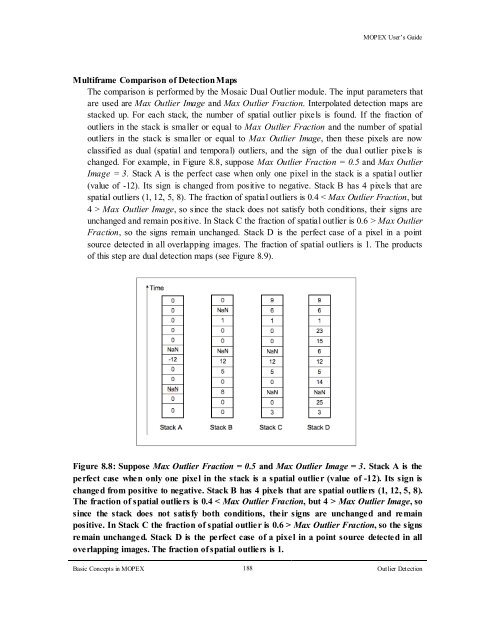Create successful ePaper yourself
Turn your PDF publications into a flip-book with our unique Google optimized e-Paper software.
<strong>MOPEX</strong> User’s <strong>Guide</strong><br />
Multiframe Comparison of Detection Maps<br />
The comparison is performed by the Mosaic Dual Outlier module. The input parameters that<br />
are used are Max Outlier Image and Max Outlier Fraction. Interpolated detection maps are<br />
stacked up. For each stack, the number of spatial outlier pixels is found. If the fraction of<br />
outliers in the stack is smaller or equal to Max Outlier Fraction and the number of spatial<br />
outliers in the stack is smaller or equal to Max Outlier Image, then these pixels are now<br />
classified as dual (spatial and temporal) outliers, and the sign of the dual outlier pixe ls is<br />
changed. For example, in Figure 8.8, suppose Max Outlier Fraction = 0.5 and Max Outlier<br />
Image = 3. Stack A is the perfect case when only one pixel in the stack is a spatial outlier<br />
(value of -12). Its sign is changed from positive to negative. Stack B has 4 pixels that are<br />
spatial outliers (1, 12, 5, 8). The fraction of spatial outliers is 0.4 < Max Outlier Fraction, but<br />
4 > Max Outlier Image, so since the stack does not satisfy both conditions, their signs are<br />
unchanged and remain positive. In Stack C the fraction of spatial outlier is 0.6 > Max Outlier<br />
Fraction, so the signs remain unchanged. Stack D is the perfect case of a pixel in a point<br />
source detected in all overlapping images. The fraction of spatial outliers is 1. The products<br />
of this step are dual detection maps (see Figure 8.9).<br />
Figure 8.8: Suppose Max Outlier Fraction = 0.5 and Max Outlier Image = 3. Stack A is the<br />
perfect case when only one pixel in the stack is a spatial outlier (value of -12). Its sign is<br />
changed from positive to negative. Stack B has 4 pixels that are spatial outliers (1, 12, 5, 8).<br />
The fraction of spatial outliers is 0.4 < Max Outlier Fraction, but 4 > Max Outlier Image, so<br />
since the stack does not satisfy both conditions, their signs are unchanged and remain<br />
positive. In Stack C the fraction of spatial outlier is 0.6 > Max Outlier Fraction, so the signs<br />
remain unchanged. Stack D is the perfect case of a pixel in a point source detected in all<br />
overlapping images. The fraction of spatial outliers is 1.<br />
Basic Concepts in <strong>MOPEX</strong> 188<br />
Out lier Det ect ion





